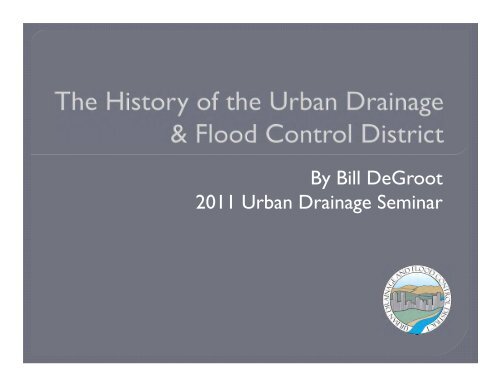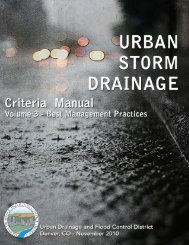History of Urban Drainage and Flood Control District
History of Urban Drainage and Flood Control District
History of Urban Drainage and Flood Control District
Create successful ePaper yourself
Turn your PDF publications into a flip-book with our unique Google optimized e-Paper software.
By Bill DeGroot<br />
2011 <strong>Urban</strong> <strong>Drainage</strong> Seminar
Medicare <strong>and</strong> Medicaid signed into law<br />
First American combat troops arrive in Viet Nam<br />
Beatles perform first stadium concert at Shea<br />
Stadium in New York<br />
Edward White is first American to walk in space<br />
I graduated from high school<br />
Many <strong>of</strong> you were a twinkle in your daddy’s eye<br />
Major floods in Colorado
Zymurgy’s Seventh Exception to<br />
Murphy’s Law:<br />
When it rains it pours
Five County Engineer’s Council<br />
• County engineers from Adams, Arapahoe, Boulder,<br />
Denver <strong>and</strong> Jefferson Counties<br />
• Also engineers from Public Service Company, Mountain<br />
Bell, Denver Water Board, Littleton, Englewood,<br />
Portl<strong>and</strong> Cement Association <strong>and</strong> Wheat Ridge Water<br />
<strong>and</strong> Sanitation <strong>District</strong><br />
• State Senator Joe Shoemaker became involved in 1967
The Five County Engineer’s Council became<br />
the Metropolitan <strong>Urban</strong> <strong>Drainage</strong> Advisory<br />
Committee <strong>of</strong> the Denver Regional Council <strong>of</strong><br />
Governments (DRCOG)<br />
DRCOG hired Wright-McLaughlin to prepare<br />
an <strong>Urban</strong> Storm <strong>Drainage</strong> Criteria Manual<br />
The Advisory Committee helped DRCOG<br />
with policy questions during preparation <strong>of</strong> the<br />
Manual
The policy decisions <strong>and</strong> an article by<br />
Shoemaker entitled “An Engineering-Legal<br />
Solution to <strong>Urban</strong> <strong>Drainage</strong> Problems” which<br />
appeared in the Denver Law Journal became the<br />
framework for the formation <strong>of</strong> the <strong>District</strong><br />
The Advisory Committee decided to pursue<br />
legislation in 1969 which would create an<br />
<strong>Urban</strong> <strong>Drainage</strong> <strong>and</strong> <strong>Flood</strong> <strong>Control</strong> <strong>District</strong>
Senator Shoemaker introduced the legislation<br />
in the Senate, <strong>and</strong> it passed 26 to 7 with 2<br />
absent<br />
Representative Ted Bryant introduced the<br />
legislation in the House, where it was going<br />
nowhere<br />
Then, on a Saturday in May it began to rain. It<br />
rained all weekend <strong>and</strong> gave no sign <strong>of</strong> letting<br />
up
Representative Bryant advised the House that if<br />
they wanted the rain to stop they should pass the<br />
bill, which they did, 49 to 14 with 2 absent<br />
Governor Love signed the bill <strong>and</strong> the <strong>District</strong><br />
was born<br />
The <strong>District</strong> began operations later in 1969 with a<br />
staff <strong>of</strong> two <strong>and</strong> authorization to levy up to 0.1<br />
mills for general fund operating expenses
The <strong>District</strong> assumes responsibility for the<br />
<strong>Urban</strong> Storm <strong>Drainage</strong> Criteria Manual
Longmont <strong>and</strong> surrounding areas removed<br />
from the <strong>District</strong>
The Master Planning Program was begun<br />
• The first master planning study was for Weir Gulch <strong>and</strong><br />
S<strong>and</strong>erson Gulch<br />
Decision to use future conditions hydrology<br />
was made
Master Planning Program Key Policy Decisions<br />
• Each master plan must be requested by local<br />
governments <strong>and</strong> be multi-jurisdictional<br />
• Completed by consultants acceptable to all parties<br />
• <strong>District</strong> provides mapping <strong>and</strong> 50% <strong>of</strong> consulting costs.<br />
Local sponsors pay other 50%<br />
• Final plan must be acceptable to all affected local<br />
governments
Project REUSE (Renewing the Environment<br />
through <strong>Urban</strong> Systems Engineering) was<br />
begun<br />
• Sponsored by HUD ($200,000), DRCOG ($60,000)<br />
<strong>and</strong> the <strong>District</strong> ($40,000)<br />
• Dual program directed at metropolitan urban drainage<br />
<strong>and</strong> metropolitan solid waste disposal problems
Purposes <strong>of</strong> the project were:<br />
• Analyze the existing situation<br />
• Develop recommendations for immediate projects<br />
• Establish priorities for future planning<br />
• To prepare a 20-year planning <strong>and</strong> implementation program<br />
for urban drainage <strong>and</strong> solid waste management<br />
Most important to the <strong>District</strong> was the<br />
opportunity to identify drainage <strong>and</strong> flood control<br />
problems, <strong>and</strong> identify strategies to address those<br />
problems
Project REUSE results:<br />
• Inventory <strong>of</strong> drainage basins<br />
• <strong>Drainage</strong> basins divided into sub-basins <strong>of</strong> 1000 to 3000<br />
acres<br />
• A numbering system was developed which is still used today<br />
• A master planning methodology<br />
• An underst<strong>and</strong>ing <strong>of</strong> the existing situation on the<br />
ground
Based on the Project REUSE findings the<br />
<strong>District</strong> adopted a two-pronged approach <strong>of</strong><br />
fixing existing problems while working to<br />
prevent new ones from being created.<br />
Remedial<br />
•Design <strong>and</strong><br />
construction<br />
Preventive<br />
• <strong>Flood</strong>plain<br />
Management
The <strong>District</strong> requested that the legislature<br />
authorize 0.4 mill for design <strong>and</strong> construction<br />
projects, which it did, effective in 1974<br />
The <strong>Flood</strong>plain Management Program was<br />
authorized to begin in 1974<br />
• Funded out <strong>of</strong> the existing 0.1 mill levy
After the legislature authorized the construction mill levy,<br />
the Board <strong>of</strong> Directors established the<br />
“Capital Improvements Expenditure Policy”<br />
• The proposed improvements must be requested by local public<br />
bodies<br />
• The proposed improvements must have been master planned<br />
• The local public bodies must share 50% <strong>of</strong> the cost <strong>of</strong> the project<br />
• The local public bodies must agree to own <strong>and</strong> maintain the<br />
completed facilities<br />
• Revenues received from each county will be spent for<br />
improvements benefitting that county over a period from 1974<br />
to five years in the future<br />
• The <strong>District</strong> will not develop a public works department but will<br />
rely on existing local government public works departments
Miller’s Law:<br />
You can’t tell how deep a puddle is<br />
until you step in it
<strong>Flood</strong>plain Management Program<br />
• National <strong>Flood</strong> Insurance Program<br />
• <strong>Flood</strong>plain Regulation<br />
• <strong>Flood</strong> Hazard Area Delineation (FHAD)<br />
• <strong>Flood</strong> Warning<br />
• <strong>Flood</strong> Damage Surveys<br />
• Reviews <strong>of</strong> Proposed Developments<br />
• Public Information
The Board authorized design <strong>and</strong> construction<br />
projects for<br />
• Englewood <strong>and</strong> Holly Dams<br />
• Niver Creek<br />
• Viele Channel<br />
Authorized design for Weir Gulch
FPM began a concerted effort to complete<br />
FHAD studies <strong>of</strong> undeveloped floodplains<br />
Cooperative efforts with Colorado Water<br />
Conservation Board, Corps <strong>of</strong> Engineers <strong>and</strong><br />
Soil Conservation Service.
Decision was made to publish separate Master<br />
Planning <strong>and</strong> <strong>Flood</strong> Hazard Area Delineation<br />
reports<br />
Decision was made to not show floodways on<br />
the FHAD maps but to put them in a table<br />
instead
0.5 ft. rise in WSEL<br />
Don’t show floodway on<br />
the maps<br />
Put in table in report<br />
Reasoning: To put a<br />
floodway on the map is<br />
to send the message “Fill<br />
to this line.”
Teamed with the Federal Insurance<br />
Administration (FIA) to work with local<br />
governments with defined floodplains to adopt<br />
adequate floodplain regulations<br />
All local governments with FIA published<br />
<strong>Flood</strong> Insurance Maps were in compliance with<br />
National <strong>Flood</strong> Insurance Program<br />
requirements.
Began a planning study for a flood warning<br />
system for Boulder Creek
Board <strong>of</strong> Directors decided to make a special<br />
effort to notify occupants <strong>of</strong> floodplains <strong>of</strong> the<br />
flood potential they faced
Board decided to request maintenance funding<br />
from the 1977 legislature
The initial flood warning system was<br />
implemented in the Boulder Creek watershed
Legislature refused to authorize maintenance<br />
funding
Board <strong>of</strong> Directors authorized funds from the<br />
Capital Improvements Budget to assist local<br />
governments with maintenance <strong>of</strong> <strong>District</strong> funded<br />
facilities with the following policy decisions<br />
• Revenues received from each county will be spent for<br />
maintenance in that county<br />
• Local governments will not be required to match <strong>District</strong><br />
funds<br />
• Contract for maintenance activities (no public works<br />
department)<br />
Decided to again request maintenance mill levy<br />
from the legislature
Maintenance Program was started<br />
Legislature approves 0.4 mill levy for<br />
maintenance <strong>and</strong> preservation <strong>of</strong> floodplains<br />
<strong>and</strong> floodways<br />
• Limited to three years (1981-1983)
Maintenance Eligibility Program started for<br />
facilities constructed by or approved for<br />
construction by local governments<br />
Requirements<br />
• Approve construction plans<br />
• Observe construction<br />
• Accept construction<br />
• Approve the project for maintenance eligibility
Legislature authorized 0.1 mill levy for South<br />
Platte River (excluding Boulder County, <strong>and</strong><br />
later, Broomfield)
<strong>District</strong> began its involvement in stormwater<br />
quality activities (in the Master Planning<br />
Program) in response to CWA amendments<br />
• Coordinated Phase I communities for<br />
consistency <strong>of</strong> NPDES<br />
permit applications.<br />
• Later did the same for<br />
Phase II communities<br />
• Also, stormwater quality<br />
research <strong>and</strong> BMP’s
<strong>District</strong> adds approximately 400 square miles<br />
to the east <strong>and</strong> southeast
Taxpayer’s Bill <strong>of</strong> Rights (TABOR) adopted by<br />
the voters<br />
This freezes <strong>District</strong> revenues at inflation plus<br />
growth<br />
Effectively ends future additions to service<br />
area by the legislature
<strong>Urban</strong> Storm <strong>Drainage</strong> Criteria Manual Volume 3,<br />
Best Management Practices is published for the<br />
first time
Leo Miser’s First Computer Axiom:<br />
When putting it into memory,<br />
remember where you put it.
<strong>District</strong> becomes FEMA’s first Cooperating<br />
Technical Partner (CTP)
Information Services <strong>and</strong> <strong>Flood</strong> Warning<br />
Program was spun <strong>of</strong>f from <strong>Flood</strong>plain<br />
Management Program<br />
• Manages all <strong>District</strong> internal <strong>and</strong> external information<br />
services<br />
• Manages the <strong>District</strong>’s Flash <strong>Flood</strong> Prediction Program
Design <strong>and</strong> Construction, Maintenance <strong>and</strong><br />
South Platte River Programs combined into<br />
the Design, Construction <strong>and</strong> Maintenance<br />
Program
1969 2011<br />
Mayor <strong>and</strong> 3 council members from<br />
Denver<br />
One county commissioner from each <strong>of</strong><br />
Adams, Arapahoe, Boulder, Douglas <strong>and</strong><br />
Jefferson Counties<br />
One mayor from an incorporated area in<br />
each <strong>of</strong> Adams, Arapahoe, Boulder <strong>and</strong><br />
Jefferson Counties appointed by the<br />
Governor<br />
Two PE’s selected by the Board<br />
Mayor or Deputy Mayor <strong>and</strong> 3 council<br />
members from Denver<br />
Same<br />
Same<br />
Same<br />
Total 15 Total 22<br />
Mayor or Deputy Mayor <strong>of</strong> Broomfield<br />
Mayor or Deputy Mayor <strong>of</strong> each city with<br />
population > 100,000 people
YEAR POPULATION POPULATION<br />
INCREASE<br />
PERCENTAGE<br />
INCREASE<br />
1960 934,253 318,618 51.8<br />
1969 –<br />
<strong>District</strong><br />
created<br />
1970 1,238,273 304,020 32.5<br />
1980 1,618,461 380,188 30.7<br />
1990 1,848,319 229,858 14.2<br />
2000 2,302,650 454,331 24.6<br />
2007 2,760,000<br />
(est.)<br />
457,350 19.9<br />
Source: Denver Regional Council <strong>of</strong> Governments
Through planning, design, construction,<br />
maintenance, <strong>and</strong> floodplain management by<br />
the <strong>District</strong> <strong>and</strong> its local government partners<br />
we have reduced the number <strong>of</strong> units in<br />
defined 100-year floodplains by about 5000<br />
units while our population has tripled.
1974 Photo 2009 Photo
1978 <strong>Flood</strong>plain<br />
UDFCD<br />
USACE<br />
CWCB
2009 <strong>Flood</strong>plain
Both floodplains
1974 Photo 2009 Photo
1978 <strong>Flood</strong>plain
2009 <strong>Flood</strong>plain
Both floodplains
•Meadowood Golf<br />
Course
•Left half <strong>of</strong> photo is ‘80’s<br />
channelization philosophy<br />
•Right half <strong>of</strong> photo is<br />
basically a preservation<br />
option with trail
Preservation
Naeser’s Law:<br />
You can make it foolpro<strong>of</strong>, but you<br />
can’t make it damnfoolpro<strong>of</strong>
•Columbine<br />
Country Club<br />
•Dutch Creek<br />
Capital<br />
Improvements
•Columbine<br />
Country Club<br />
•Three Lakes<br />
Tributary<br />
Capital<br />
Improvements
Matz’s Maxim:<br />
A conclusion is the place where you<br />
got tired <strong>of</strong> thinking.

















